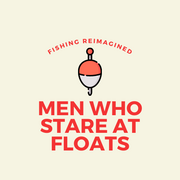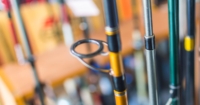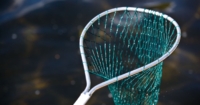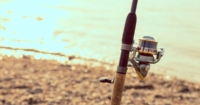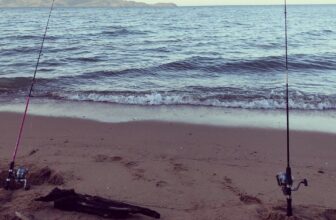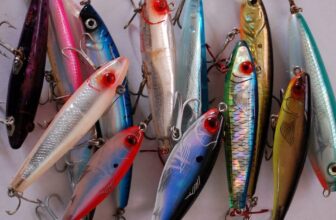Some links on this page are affiliate links, which do not impact our impartiality. We recommend the best product and then find out if it is available through one of our partners.
Choosing the right fishing reel is a beginner’s nightmare. There are so many different things to consider; from casting distance and accuracy to gear ratios and drag systems, it can feel like a real black hole of information.
In this thorough guide to choosing the right fishing reel, we will cover all the essentials. If you don’t know what a gear ratio is or why it matters you’re about to find out. We’ll begin with a clear glossary before diving into why size matters. Although of course, that’s not the only thing. Power output is just as important. As is accuracy.
So whether you’re in the market for excellent saltwater spinning reels, some of the best baitcasting reels or just something for absolute beginners we’ve got you covered. So let’s get started.

Fishing reel glossary
Before we get into the meat of the post let’s break down some of the more technical terms we’re going to cover in this post.
- Reel type: If you’re fly fishing you need a fly fishing reel. Ditto with trolling. Spinning and deadbaiting can be done on spinning, spincast or baitcaster reels.
- Gear ratio: The gear ratio on a reel refers to the number of times the spool rotates for every single turn of the handle. Higher gear ratios are better for fast retrieves and for fighting larger fish. It is referred to as a ratio e.g. 5:1
- Ball bearing number: Refers to the number of ball bearings used in the reels’ construction. They are used to reduce friction and a reel with a higher number of ball bearings is considered better quality, with a smoother drag system
- Drag system: A fishing reel’s drag system is the mechanism that controls the amount of resistance when a fish is pulling on the line. The tension applied when fighting a fish can be adjusted to tire out larger fish. There are two main types; star drag and lever drag.
- Trolling: Trolling is a type of fishing done from a boat where lures or bait are dragged behind the boat on powerful rods designed to target ultra powerful fish.
Table of contents
The 10 Best Lure Fishing Rods in 2023 Editor’s choice
How do I choose a fishing reel?
When choosing a fishing reel the most important things to consider are the type of fishing you’re going to be doing, the type and size of fish you’re targeting and to ensure it pairs well with the rod you have in mind. We’d say the five most important considerations are:
- Reel type: There are several types of reels that have their own specifications. Spinning, spincast and baitcasting reels are all suitable for lure fishing and deadbaiting. Trolling reels are for deep sea boat anglers, centre pin reels for float fishing and fly fishing reels are for – you’ve guessed it – fly fishing.
- Type of fishing: If you are going fly fishing then you need a fly fishing reel. That’s easy. If you’re going lure fishing then spinning, spincast or baitcasting reels are all salient options. Spincast reels are best for beginners whereas baitcasting reels are only suitable for experienced anglers.
- Durability: This is particularly important when fishing in saltwater conditions. Salt has a corrosive effect on reels and can ruin a reel’s drag system and smoothness on the retrieve. Saltwater-specific reels still require cleaning but are substantially more robust
- Gear ratio: A higher gear ratio is better suited to targeting larger, more powerful fish as you can retrieve the line in faster. A gear ratio of 6.2:1 is considered ‘fast.’
- Reel size: Reel size refers to its line capacity. A 6000-size reel has a higher line capacity than a 2000-size reel. Typically 2000 to 3000 is a good starting point for most fishermen as these reels can hold up to 200 yards of quality braid.
For example, if you’re planning on doing a lot of saltwater fishing, targeting larger, more powerful predators, then you need a lure with a larger line capacity, stronger drag system, saltwater durability and a higher gear ratio so that it can reel line in faster.
What types of fishing reels are there?
There are three main types of fishing reels to choose from:
Spinning reels
Spinning reels are mounted on the underside of the rod and operated by a handle that is turned to retrieve the line to the side of the rod. Suitable for casting lures in both salt and freshwater conditions. They’re ultra-flexible reels great for beginner and intermediate anglers.
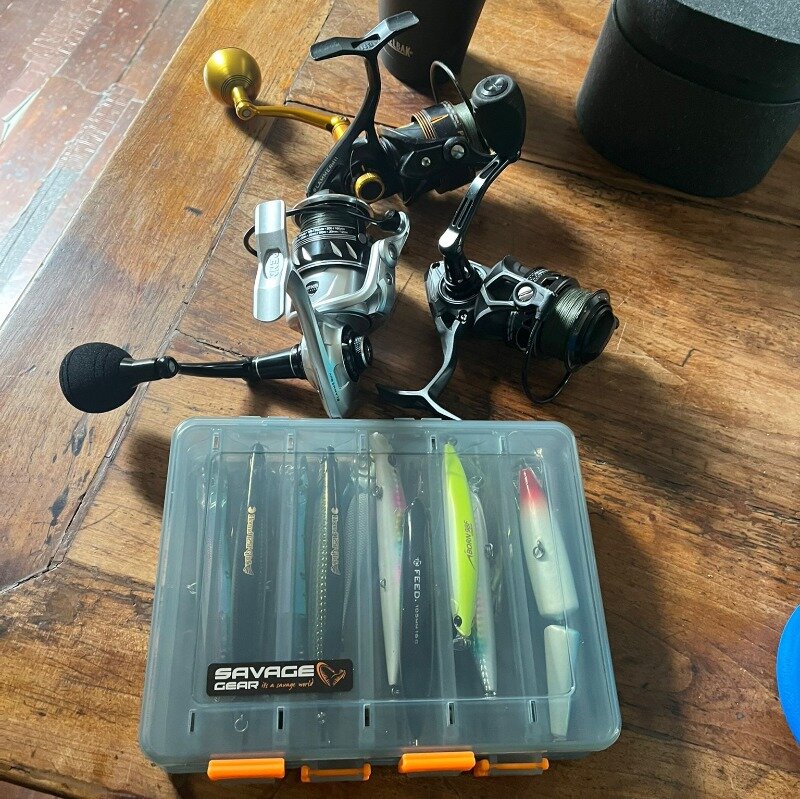
Baitcasting reels
Baitcasting reels are similar in spec to spinning reels but are mounted on top of the rod as opposed to the side like spinning reels. They’re generally used by more experienced anglers as they have improved casting accuracy and a thumb-controlled spool release that gives you control over the amount of line released. The downside to baitcasting reels is the increased likelihood of snags (or bird’s nests), hence their lack of suitability for beginners.
Spincast reels
A spincast reel is a hybrid of spinning and baitcasting reels and is designed for beginner anglers. Similar to a spinning reel in terms of setup, a spincast reel has a fixed spool mounted on the bottom of the reel. However, instead of having an open face like a spinning reel, it’s enclosed like a baitcaster. This reduces snags as the angler is no longer required to hold the line. The trade-off is distance and accuracy.
The 8 Best Fishing Nets in 2023 Editor’s choice
Then – for the more experienced or specific fishermen there are three additional types of reels:
Trolling reels
Trolling reels are the largest, most powerful reels on the market with a high line capacity, strong drag system and superb durability. They are designed to handle larger baits, huge fish and the stress of trolling, where a lure is dragged behind a moving boat.

Fly fishing reels
A fly fishing reel is a reel specifically designed for fly fishing. They’re designed to hold the thicker fly line with fast line retrieval and an ultra-smooth and precise drag system providing excellent tension control when fighting a fish. Essential as fly rods have very light tips. They’re usually smaller and lighter than other reels, free-from gears, levers and typical lure mechanics.
Centre pin reels
A centre pin reel (or float reel to the initiated) is a type of fishing reel designed for float fishing. Its large circular spool that’s mounted in the centre of the reel is designed for us with much longer rods as the centre mount allows the line to flow freely off the spool during the cast. Much like a baitcaster. Their very smooth, drag-free drift is only really suitable for freshwater fishing.
What are the pros and cons of each type of fishing reel?
Spinning reels
Baitcasting reels
Spincast reels
Fly fishing reels
Trolling reels
Centre pin reels
A breakdown of each fishing reel type
The below table breaks down the differences between the three main types of fishing reels: spinning reels, baitcasting reels and spincast reels alongside trolling reels fly fishing reels and centre pin reels. We have also included a breakdown of trolling reels, Fly fishing reels and centre pin reels although they have some unique features and characteristics that make them different from other reel types.
| Feature | Spinning Reel | Baitcasting Reel | Spincast Reel | Trolling Reel | Fly Fishing Reel | Centre Pin Reel |
|---|---|---|---|---|---|---|
| Reel Type | Open-faced | Closed-faced | Closed-faced | Conventional | Single action | n/a |
| Drag System | Rear | Star drag | Push-button | Lever drag | n/a | n/a |
| Ball Bearings | 1 – 14 | 1 – 7 | 1 – 3 | 2 – 4 | 1 – 3 | 1 – 3 |
| Gear Ratio | 4.9:1 – 6.2:1 | 6.3:1 – 7.1:1 | 2.5:1 – 4.1:1 | 2.5:1 – 6.3:1 | 1:1 | 1:1 |
| Brake System | Disc Drag | Magnetic | Tug and Push | Star Drag | n/a | n/a |
| Retrieval Rate | Fast | Fast | Fast | Fast | Medium | Medium |
| Durability / Construction | Light – Heavy | Light – Heavy | Light – Heavy | Heavy-Duty | Light – Medium | Light – Medium |
| Brand Examples | Penn, Shimano | Abu Garcia, Daiwa | Zebco, Mitchell | Penn, Shimano | Orvis, Sage, Ross | |
| Price | £ – ££££ | £££ – ££££ | £ – ££ | £££ – £££££ | ££ – ££££ | ££ – ££££ |
What are fishing reel sizes?
The size of a fishing reel is represented by a numerical code in the thousands that indicates the line capacity, gear ratio and power output the reel has. Typically these numbers look like 1000, 2000, 3000 – all the way up to 30000. Although it’s unlikely you’d ever need a reel over the 5000 size unless you’re targeting some pretty serious fish.
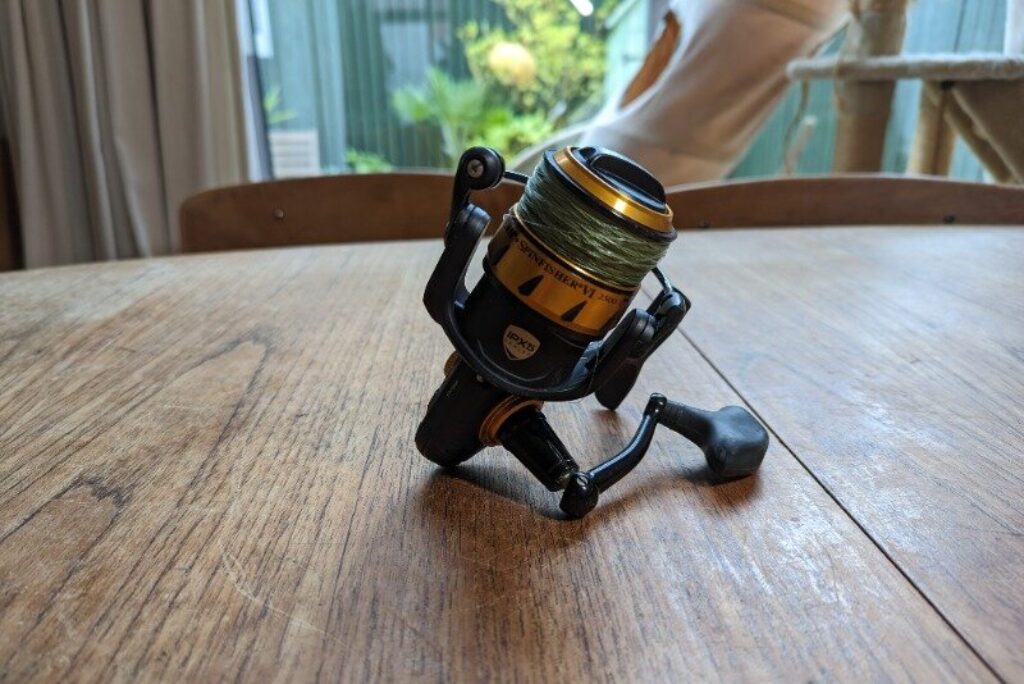
Unfortunately, there’s no standard size code for reels the overwhelming majority of manufacturers use this style of code. Occasionally you may see 025, or 035 instead. This works in the same way and 025 typically means 2500.
Fishing reel size chart
The below table provides a breakdown of reel sizes including the line capacity, gear ratio, durability, price and target species. These are all illustrative and designed to serve as guidelines as opposed to hard and fast rules. Each aspect is subject to change based on factors including the weight and quality of the line* and manufacturer.
| Reel Size | Line Capacity (yd) | Gear Ratio | Ball Bearings | Price Range | Durability | Target Fish |
|---|---|---|---|---|---|---|
| 1000 | Up to 100 | 4.6:1 | 1-2 | £ – £££ | Low | Trout |
| 2000 | Up to 150 | 5.2:1 | 1-3 | £ – £££ | Low – Medium | Bass |
| 3000 | Up to 250 | 6.2:1 | 2-4 | ££ – ££££ | Medium | Salmon |
| 4000 | Up to 300 | 6.2:1 | 3-5 | ££ – ££££ | Medium – High | Catfish |
| 5000 | Up to 400 | 6.2:1 | 4-6 | ££ – ££££ | Medium – Very High | Catfish |
| 6000 | Up to 500 | 6.2:1 | 5-7 | £££ – £££££ | High – Very High | Dorado |
| 7000 | Up to 600 | 6.2:1 | 6-8 | £££ – £££££ | High – Very High | Tuna |
| 8000 | Up to 700 | 6.2:1 | 7-9 | £££ – £££££ | High – Very High | Sailfish |
*Higher quality braid is thinner than a traditional line and increases the line capacity your reel can hold. Of course, the inverse is true too. So make sure you get one of the best braided fishing lines available.
What is the standard reel size?
There is no standard size for all different types of fishing as it depends on the type of fishing you’re planning on doing, the size of fish you’re targeting and the prevailing conditions. However, reels around the 2000 – 3000 size should have ample line and power to target the majority of fish you’re looking to catch. This covers the majority of spinning and baitcasting options.
Important to note that fly fishing reel sizes follow a different measurement system and are noted as 4/5, 5/6, 7/8 etc. A 5/6 fly fishing reel means it is suitable for 5 or 6-pound line.
How do I know what size reel to get?
This all comes down to the type of fishing you’re doing. Lure fishing for larger predators in the sea is going to require a larger lure than when you’re fishing for chub in a smaller river. The line capacity and power output become more important. If you’re planning on wreck fishing for giants off the coast then you’ll need an even larger more powerful reel to cope with the line capacity and drag requirements.
A good rule of thumb is to start with a 2500 or so-sized reel which is an excellent beginner option that’s ultra-versatile. Every angler needs this size reel. Once you’ve got one of these you can start to branch out a little more.
How do I match a reel to a rod?
When matching a reel and a rod together there are a few key considerations:
- The type of fishing you’re doing
- Line weight and capacity
- Rod action
- Rod power
- Reel seat
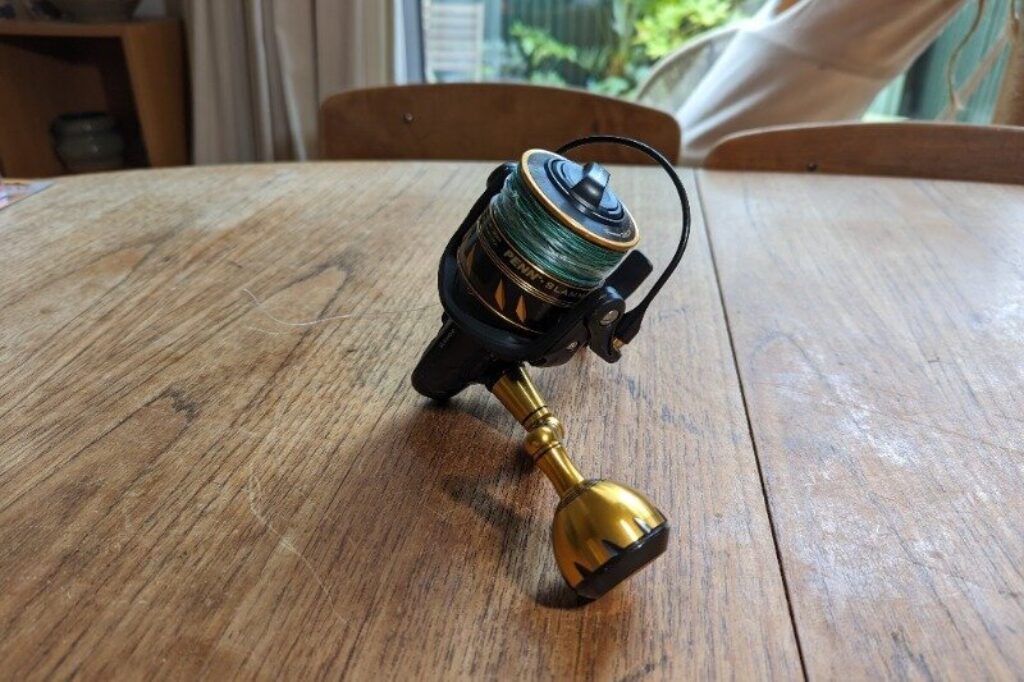
The first step when matching a reel to your rod is to define the type of fishing you’re doing. Lure fishing requires a spinning, spincast or baitcaster reel matched with a more powerful, fast action rod. Whereas fly fishing requires a fly rod and reel.
Then you’ll need to consider the size of the fish you’re after. Faster more powerful fish tend to need a reel with fast action and a higher capacity reel. This is denoted by the reel size, which typically is represented as 1000, 2000, 3000 etc.
For example, If you’re targeting smaller fish in smaller bodies of water can be done with a 6-foot rod and a 1000-size reel, because casting distance and line capacity are less of a problem. Whereas fishing for bigger fish in larger bodies of water may need a longer rod and a 5000+-size reel.
From there you’ll need to ensure the maximum line weight is compatible with both the reel and rod. Typically you’ll find that rods have a line rating that suggests the breaking strength of line that can be paired with a reel. You’ll find the max line weight written on the side of the rod along with the rod length, weight, casting weight and action.
You’ll also need to consider how many pieces the rod breaks down into and what reel is best suited for that. A two-piece rod is structurally sounder than a four-piece, so can be paired with a more substantial reel. Both of which are more suitable for catching powerful fish.
When the reel is mounted on the rod place your finger just above the reel on the rod and allow the rod to rest horizontally. If it is properly balanced the rod will stay level without tipping in either direction. If it tilts backwards the reel is too heavy and vice versa.
What else do I need to consider when choosing a fishing reel?
- Cost: Of course price doesn’t mean everything when it comes down to quality. You can pick up very competent reels for £50, but could easily spend over £400 on a top-of-the-range model.
- Hand orientation (retrieve system): You can choose left or right-handed reels, so make sure you pick whatever you’re more comfortable with. Left-handed reels are designed for people who reel with their left hand (typically right-handers) and vice-versa.
- Manual or automatic (retrieve system): Manual retrieve systems require you to manually crank the handle to wind the line onto the spool. Whereas automatic retrieve systems use a built-in mechanism to the same effect. Automatic systems are much more expensive and are typically used for ultra-deep sea fishing.
The 9 Best Fishing Rods and Reel Combo in 2023
FAQs
What is the best type of fishing reel for beginners?
In our opinion, a spinning reel is the best option for beginners thanks to its ease of use. Spinning reels are suitable for any type of fishing (with the exception of fly fishing of course) and the side-mounted profile minimises snags when casting.
A good quality spinning reel with a smooth drag system and quality ball bearings will last years with a little maintenance and is well worth the investment.
What is the best type of fishing reel?
A spinning reel is the best type of fishing reel thanks to its versatility, beginner-friendly design and capacity to handle a wide variety of fishing methods. Whilst baitcasters are better when it comes down to casting distance and accuracy, they’re more prone to tangling and require more expertise. Spincasts are a great beginner option, but spinning reels are more flexible.
What type of reel is the most accurate?
Baitcasting reels are the most accurate type of reel on the market largely thanks to the top-mounted setup and revolving spool operated by a trigger-like thumb button. The spool rotates as you cast and the amount of line released can be controlled by your finger. However, they are much more prone to snagging (or bird’s nests) than spinning reels and require more expertise.
What type of reel is best for big fish
A baitcasting reel is considered the best option when fishing for big fish provided you are experienced enough to use one. Baitcasting reels offer more power and casting accuracy thanks to their top-mounted setup and revolving, finger-operated spool. However, they require more angling experience, and spinning reels are a better beginner-intermediate option.
If you’re fishing for saltwater giants from a boat, you may want to consider a trolling reel, as these tend to be the most powerful.
What does 5:1 mean on a fishing reel?
5:1 denotes the reel’s gear ratio. The gear ratio is the number of times the reel’s spool had to rotate for every single turn of the handle when retrieving the line. A gear ratio of 5:1 means that for every single turn of the handle the spool rotates five times. This is considered a relatively fast gear ratio associated with lure fishing.
A gear ratio of 6.2:1 means that for every single turn of the handle the spool has to rotate 6.2 times. This is more common with trolling or fishing for ultra-powerful fish.
Can you put any reel on any rod?
No, you can’t put any reel on any rod. Well, you can, but not successfully. Fishing reels and rods are carefully designed pieces of kit that match line weight, power, length, action, and reel seat.
A poorly matched reel and rod can lead to several problems, including poor casting distance and accuracy, broken rods, line snaps and bird’s nests (line snags). For example, a slow action rod with a max line weight of 6lb shouldn’t be used with a powerful reel loaded with 30lb braid fishing in saltwater for powerful predators.
What does 4000 mean on a fishing reel?
The number 4000 on a fishing reel refers to the reel size. The reel size indicates the diameter of the spool and in simple terms provides an indication of the reel’s line capacity.
A 4000-size reel is a medium-sized reel that typically holds around 300 yards of 8lb monofilament for a wide range of fishing methods. In comparison, a 1000-sized reel can hold around 100 and can’t target more powerful fish. Obviously better quality braid is thinner and has a greater loading capacity.
